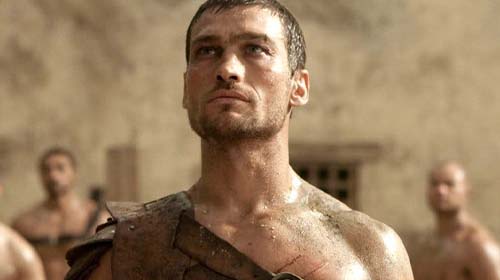26 Jun 2012 Alumni News
Andy Whitfield’s Fight For Life
Andy underwent six sessions of chemotherapy. “In some ways it was a special time,” says Vashti. “Andy was able to spend a lot of time with the children. Underlying it all was this feeling it was all going to be OK.”

Original article at The Telegraph by Kathryn Knight 25th June 2012
He was a big, strong TV star who withered away with cancer.
Andy Whitfield, who attended Screenwise Film and TV School for Actors in Surry Hills, Sydney, and played Spartacus in the show Spartacus: Blood and Sand, died on September 11, 2011.
The beloved wife of actor Andy Whitfield has tearfully recalled the brave Spartacus star’s final words to his kids: “I am like a butterfly with broken wings.”
Whitfield was preparing to shoot the second series when he was diagnosed and filming was put on hold while he fought the disease. It was a battle he chose to document with the help of award-winning documentary maker Lilibet Foster, who captured hours of intimate footage as Andy fought to get well; in turn, defiant, angry, scared and tearful as he confronted his mortality, reported website MailOnline
“Andy believed that documenting his fight might help others,” said his widow Vashti.
Filmmaker Foster said; “Andy wasn’t embarrassed to admit he was terrified, or to cry on camera,” says filmmaker Lilibet Foster. “The idea is the film will make you go out there and do everything you’ve ever wanted to do.”
It’s a view echoed by Vashti. “Andy felt so strongly that you only get one life, so you should make it count.”
The documentary is also a love story. Andy and Vashti, now 39, were in their early 20s when they were introduced by a mutual friend in London. Romance blossomed quickly: within three months they moved to Sydney after Vashti was offered work in a design agency.
They settled there, marrying in 2001. Jesse came along in May 2005 and Indigo two years later. Andy worked as an external engineer – “like a really hot Spider-Man, scaling buildings” smiles Vashti – until, aged 30, he was scouted on the beach by a modelling agency. Work flooded in, followed by TV commercials, inspiring Andy to retrain as an actor.
In 2009, Andy was offered the title role in Spartacus. While it was to prove his breakthrough, the part was gruelling, requiring hours of training to hone his body into that of a warrior. When, towards the end of filming, he began to suffer backache.
By early 2010 the pain was unbearable. “Sometimes he would lie on the floor howling like a woman giving birth,” said Vashti. It was at this point he had a full body scan, revealing he had high-grade B Cell lymphoma – the most common form of non-Hodgkin’s lymphoma, according to Dr Kirit Ardeshna, consultant haemato-oncologist at University College Hospital.
“Lymphomas are divided into two groups, Hodgkin’s and non-Hodgkin’s,” he says. “The latter is seven times more common, while the former occurs more in young people and is often more treatable.”
Non-Hodgkin’s lymphoma is a cancer of the lymphatic system. Clear fluid called lymph flows through the lymphatic vessels and contains infection-fighting white blood cells known as lymphocytes.
In lymphoma, these lymphocytes start to multiply in an abnormal way and collect in certain parts of the lymphatic system, such as the lymph nodes (glands). The affected lymphocytes lose their infection-fighting properties, increasing vulnerability to infection.
There are, says Dr Ardeshna, no typical risk factors for non-Hodgkin’s lymphoma except older age and being male. Initial symptoms are not always easy to spot.
“Non-Hodgkin’s lymphoma tends to manifest in a painless lump, a gland swollen by a centimetre or so. Less commonly, there are night sweats, unexplained fevers and weight loss,” he says.
Andy’s back pain was the result of a mass of tumours pressing against his spinal column. Without treatment, the oncologist said, Andy had three to six months to live. “He said that, given Andy’s age and fitness, with treatment there was every hope for a full recovery,” says Vashti.
“The five-year survival rate after initial chemotherapy is about 60 per cent of patients, with the two-year figure standing around 75 per cent,” says Dr Ardeshna.
Andy underwent six sessions of chemotherapy. “In some ways it was a special time,” says Vashti. “Andy was able to spend a lot of time with the children. Underlying it all was this feeling it was all going to be OK.”
And so it seemed. Six weeks after Andy’s last chemotherapy session, a scan showed the cancer had gone. ‘We thought it was a chapter closed,’ says Vashti.
Yet not for long. In September 2010, Andy had a routine medical ahead of filming the second series of Spartacus. “The scan showed a small inflamed lymph node in his abdominal area,” says Vashti.
That night, ahead of further tests, the couple went out for dinner and afterwards got matching tattoos on their arms reading ‘Be Here Now’ – the title of the documentary.
“It was our way of saying that whatever happened, we would live in the moment,” says Vashti.
The next day, a biopsy confirmed their worst fears: the cancer was back, and this time the prognosis was much more severe.
“If you relapse early the chance of surviving and responding to further treatment is much lower,” says Dr Ardeshna. “Rather like bugs and antibiotics, some cancer cells can become resistant to chemotherapy. The resistant cancer cells are the ones that continue to grow and so you have to try a different type of chemotherapy.”
Without treatment Andy had three months to live, while even with further intervention a successful outcome was far less likely.
“We had gone from ‘You’re going to get better’ to ‘You’re going to die’,” says Vashti.
The treatment now called for an aggressive form of chemo, followed, if successful, by a stem-cell transplant. Andy remained positive, inviting a documentary team to share his journey.
In early 2011, Andy embarked on his first round of high-level chemotherapy with a new drug regimen. This time the experience was markedly different.
“He was very ill. Some days he could barely drag himself out of bed. He had terrible hallucinogenic nightmares,” says Vashti.
After six weeks, a full body scan showed only a mild improvement, which was another blow. “But Andy refused to be bowed,” says Vashti.
The second series of sessions left Andy weak and spending more time in hospital – although a scan showed the cancer had reduced by 50 per cent, a major change, yet far from enough.
“On one level we were excited – but it had come at a huge cost,” says Vasti.
In May 2011, Andy embarked on his final round of chemo. “This was the worst,” says Vashti. “He was in so much pain. The big, strong man I had fallen in love with was now so fragile it was as if he was made out of tissue paper.”
A scan showed why: the cancer had not shrunk and Andy now had a mass of tumours pressing on his spinal column. “The oncologist said nothing more could be done with chemotherapy and referred us to a radiotherapist. It was now a case of trying to manage the cancer rather than cure it,” says Vasti.
The first session of radiology was ‘hell on earth’. “Andy said it was like a knife being thrust into his nervous system,” says Vasti.
Yet, over the next couple of sessions, he rallied sufficiently that, while still in pain, he was able to go out for drinks to celebrate Vashti’s 38th birthday last June.
The hiatus was short-lived. By Andy’s sixth radiotherapy session in July, he was in agony. “He had become so weak he couldn’t climb the stairs to our apartment. He had to stay in a hospice for a week,” says Vashti. Three days before his death, drifting in and out of consciousness, Andy returned to the hospice.
“To me, he had already gone. He rallied enough to say goodbye to the children. It took everything he had to sit up and pull them on to his knee then say goodbye. That’s when he spoke of the butterfly.
“Then he turned to me and said, ‘That’s all I can do now’ and I had to take them away.”
He died the following day, in Vashti’s arms.

Share this
Career focussed
Training in acting for film & television
Screenwise offers full-time and part-time intensive creative and technical accredited screen acting programs.
Explore acting courses